A Fairy Called Shyeling – Finding Your Silence Instead of Your Voice
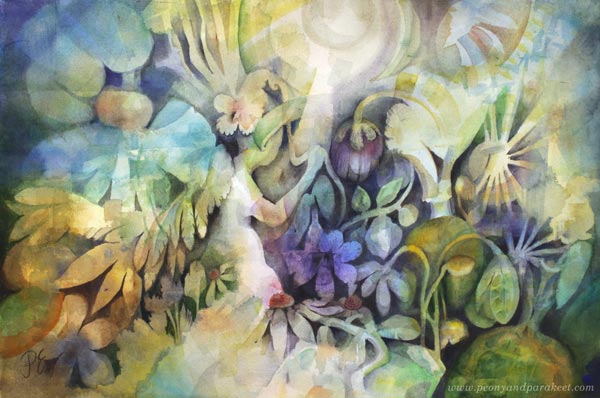
I call this watercolor painting “Ujokki” which is not a real word at all. “Ujo” means shy in Finnish. Maybe it could be something like “Shyeling” in English, expressing a timid and sensitive fantasy figure.
What Is The Shyeling?
The shyeling sees the little miracles of nature, the growth of the plants and how the light hits on the petals. She smells the soil, walks barefoot on the moss and listens to dewdrops falling on the ground. The shyeling is the most delicate and vulnerable part of us that we wish to connect and show through our art. It’s a silent power that originates from the memories and nuances rather than a loud voice demanding the ownership of the stage.
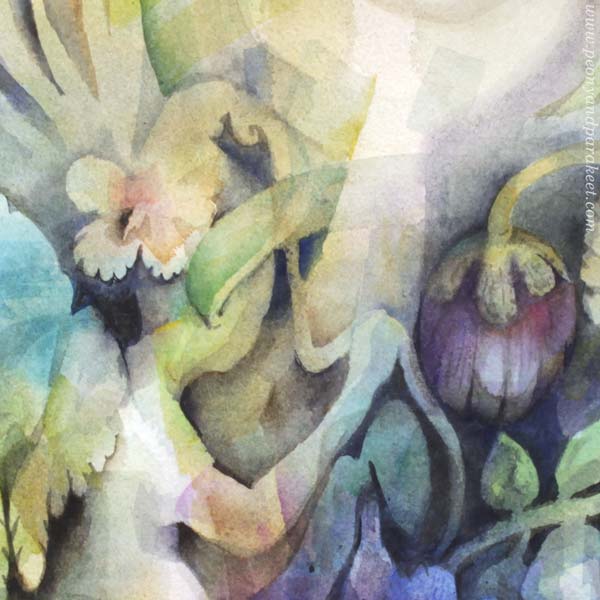
In my painting, the shyeling is pictured as a little flower fairy with big wings of imagination.
Why the Shyeling Is So Difficult to Find?
When I led IT projects and solved problems that involved different parties, personalities, and systems, the strength that I needed to possess was very different from what the shyeling has. Dealing with crises and interruptions echoed hard in my mind, and it scared my shyeling away.
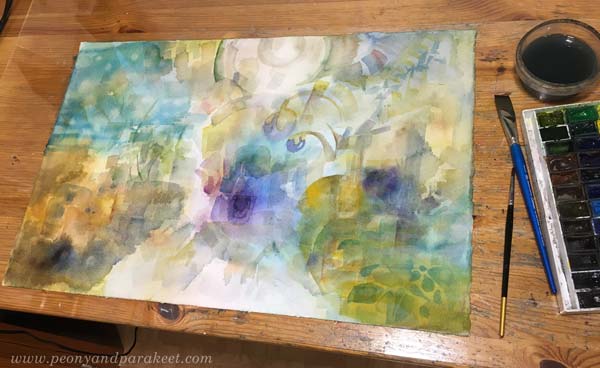
I have also mistakenly thought that shyelings are everywhere and for anyone. All my life, I have created art so that it pleases other people’s outer expectations. I haven’t even always noticed that. It’s been partly a subconscious and partly a practical thing. Shyelings don’t understand money, time, or numbers. They are weak and meaningless creatures in today’s busy world. But still, if we find ours, we don’t want to let go. We often talk about finding a visual voice, but I believe it’s more about finding our silent power.
Taming Your Shyeling
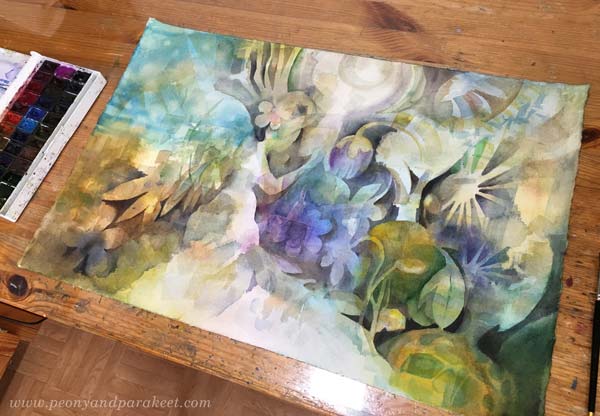
I have many paintings and drawings, where I have started to walk towards my shyeling but my impatience has taken over. The fact is that the less you have created, the longer the journey feels. But when you keep going, the destination will feel closer, and you will enter the zone where your shyeling skulks.
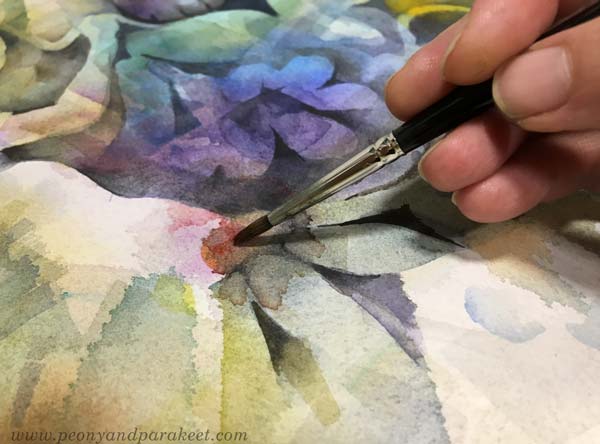
Also, remember that shyelings are like wild animals that need to be tamed. Taming needs skills, and skills need practicing. So be open to learning from other people’s shyelings. Yours might not be ready to appear from the bushes yet, but she’s been watching you, feeling more comfortable day by day.

Get Closer to Your Sheyeling!
Recently, four things have taken me closer to my shyeling. First, I have stopped questioning my love for painting plants and flowers. If I like to do that, so be it. It’s not really about replicating the plants that I see anyway, but to use their shapes for creating new organic systems.
Do this: Create a piece about things that feel too familiar to you. Keep the idea process short, almost non-existent, create what you find the easiest. But, at the same time, lengthen the time that you usually take to create a piece like that. What do you discover during that extra time?
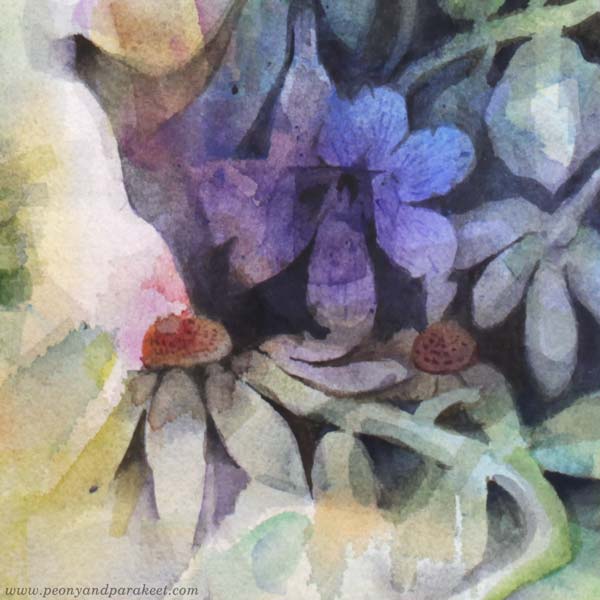
Second, I questioned why many landscape paintings look so empty to me. I found the answer from a childhood memory, always imagining nature as a luxurious place. I wrote more about this in the previous blog post.
Do this: Look at the old photos or dig our old things that reconnect you to the age when you were less than ten years old. What can’t be seen in the photos? What did you do when you were alone and nobody took pictures?
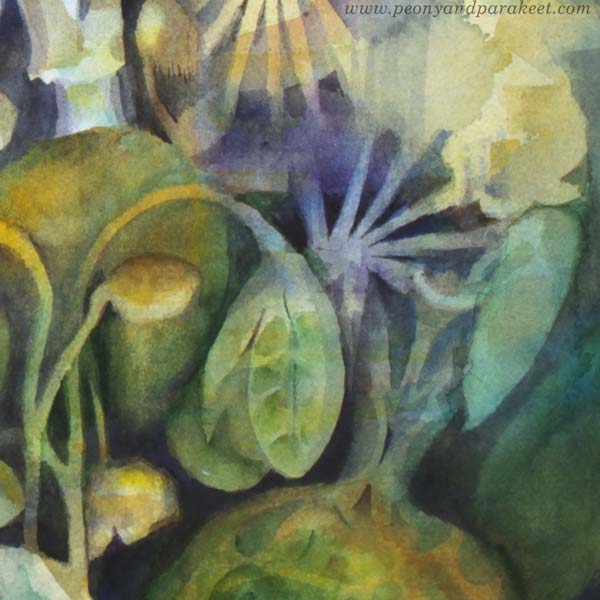
Third, I have challenged myself to become more skillful in expressing the atmosphere and space with light and shadows.
Do this: Evaluate your recent pieces so that you list things that lack there. Collect a list of things that you want to be present in your art. Then pick one thing that you start practicing more.
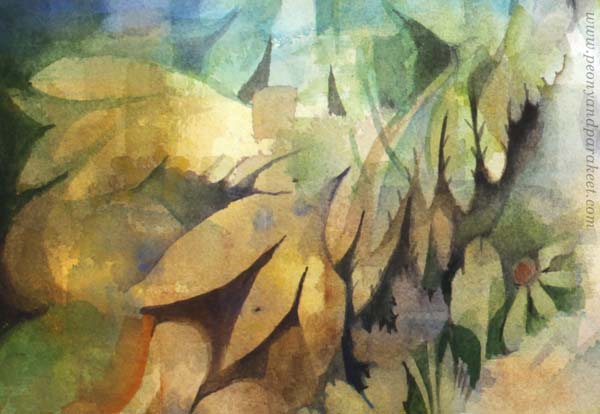
Fourth, I have practiced drawing and painting human figures without references. When I paint without references, I feel free and peacefully silent. Then there’s always a chance for my shyeling to appear.

What do you need to practice next to get closer to your shyeling?
Fantasy Forest – Combining Two Ideas in One Painting

I just finished this fantasy forest! The painting is called “Once Upon A Time.” I think this will begin a series of fantasy watercolor landscapes. Recently, I have got lots of inspiration from daily walks.
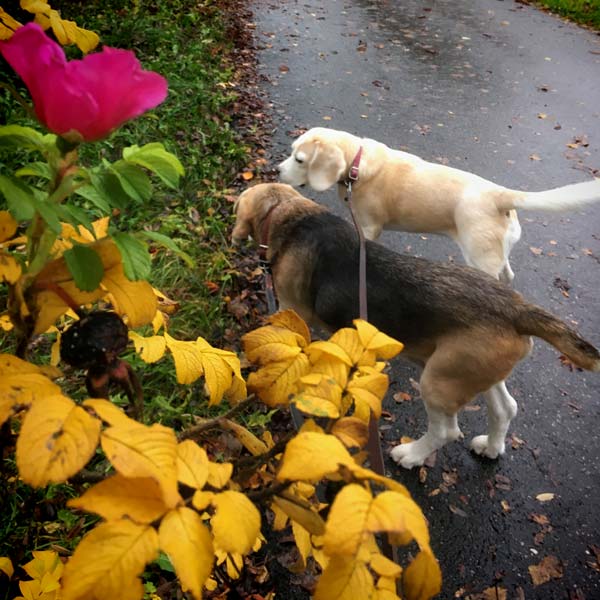
First Idea: Forest Is Like a Golden Palace
This fall has been beautiful, and I have especially enjoyed yellows and oranges. It looks like the trees are decorated with gold, and even the most modest specimens look noble and precious when the sun highlights their leaves.
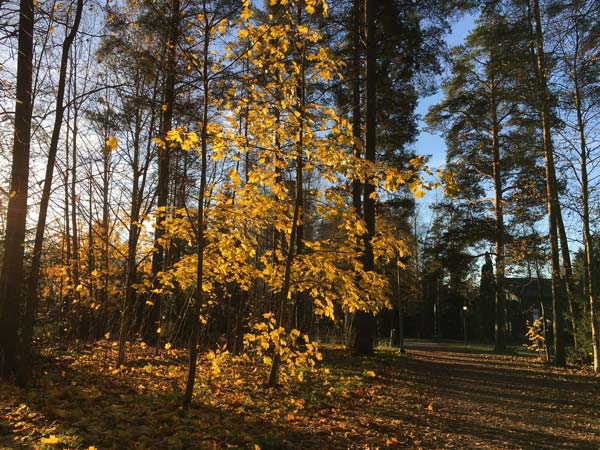
The fall sceneries took me back to childhood when I used to wander in the surroundings. Often it was an escape from boredom, sometimes from unpleasant feelings. I didn’t admire nature like adults do. I saw myself as the queen of England (because I didn’t know anything more exotic and powerful!), pacing around her palace. Trees were pillars of the luxurious hall, and the mosses were sumptuous carpets. In my eyes, every living plant became a grand artifact, contributing to my perception of ultimate beauty.
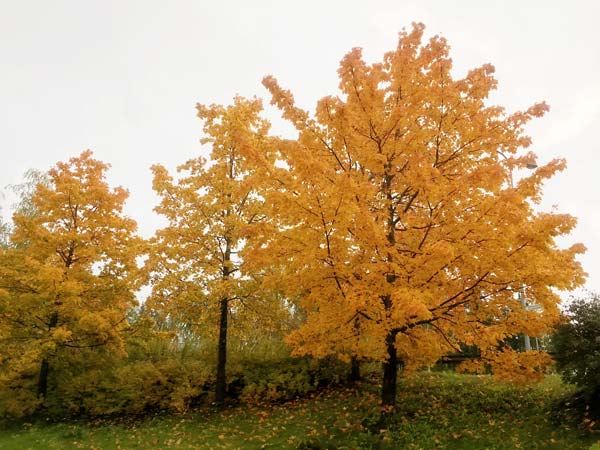
Earlier this fall, I painted this watercolor scenery that perhaps has some remains of those childhood memories.
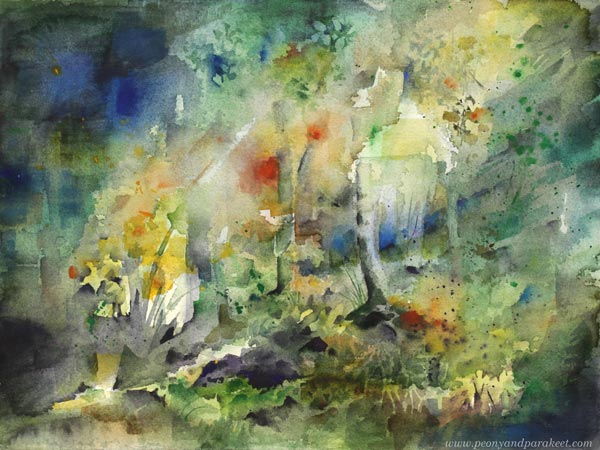
>> Watch the video of making this watercolor painting!
Two Watercolor Painting Stations
When painting with watercolor, it’s important to be patient and let the paint dry properly before adding more details on the top. I have learned that just staring at the painting and waiting for the layer to dry is not a working solution to me. I try to figure out something else to do too. This time I had two painting stations and another painting also got some layers even if I didn’t get to finish it.
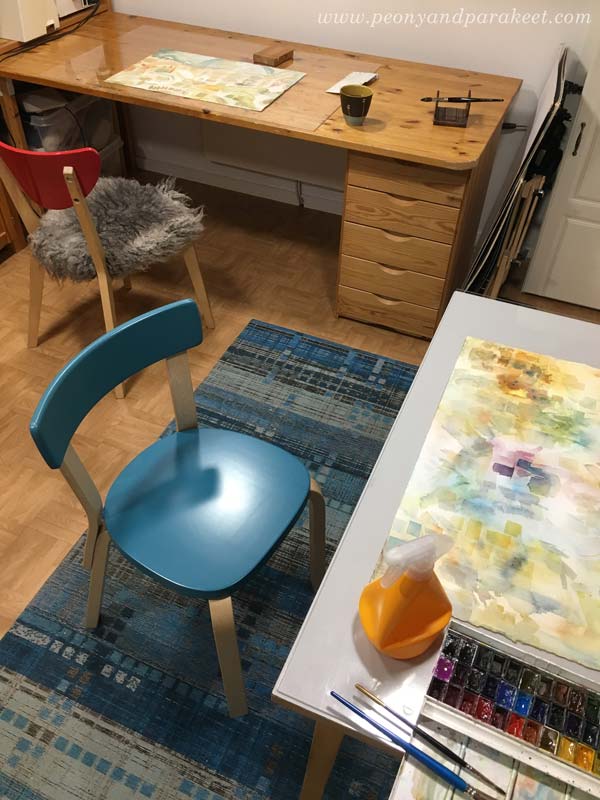
I have big plastic plates covering the top of the tables so that I can splash water quite freely.
From a Building to a Fantasy Forest
I started the paintings with simple geometric shapes and used photos of interiors as inspiration. The staircase of Palais Garnier inspired the painting of this blog post.
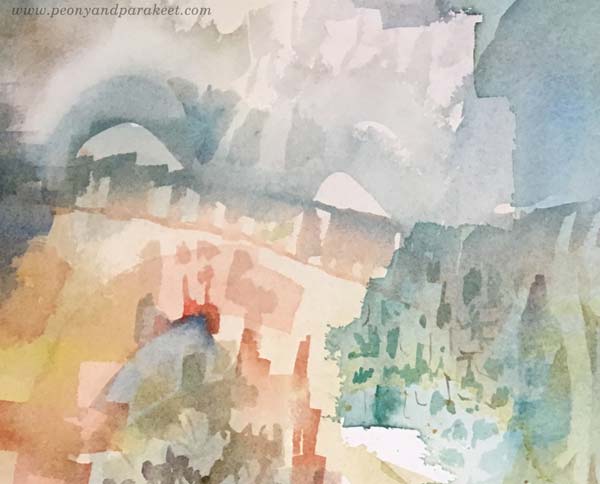
Here you see some details of the painting in an early stage. The elements are more architectural-looking than organic. Maybe because of my childhood experiences, I find it easy to see the connection between interiors and outdoor scenes. If I look at the photo like the one below, it’s more difficult for me to pick the shapes that define the 3-dimensional space.
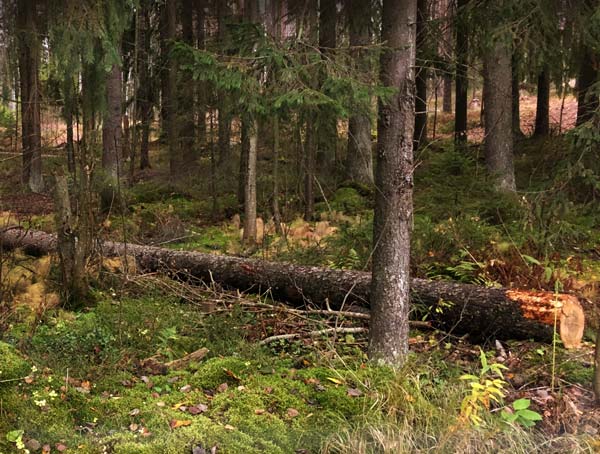
When I continue the painting, I change most of the shapes so that they are more organic.

At this point, I was working from my imagination only. I find it most freeing when I don’t have to keep any photos visible. I had quite a flow here, listening to old cembalo music and painting!
I like those leaves in the bottom corner. It’s always a bit pity when something pretty appears near the edges. I had to tone them down a bit so that they don’t steal all the attention.
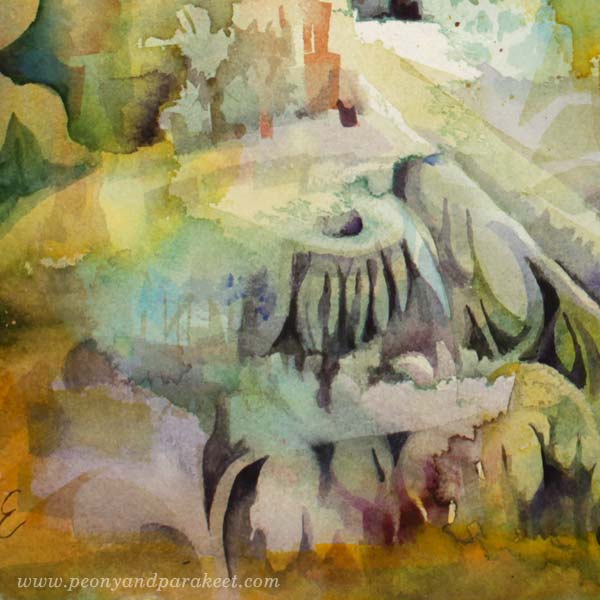
Second Idea: Orchids
Orchids have never been my thing until I received my first one from Patricia, one of my students, as a birthday present. I was so impressed by getting the orchid that I learned to take care of it. When I changed the pot, I was fascinated by its roots. The months went by, and I became more and more interested in all kinds of orchids. A few weeks ago, I went to see a show organized by The Finnish Orchid Society.
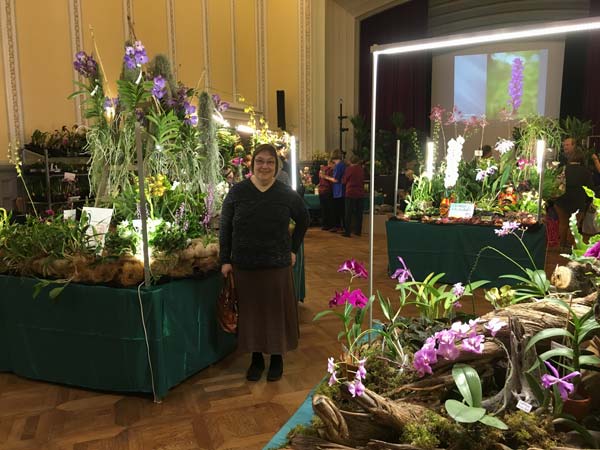
So no wonder that my second idea was to add orchids to the fantasy forest!
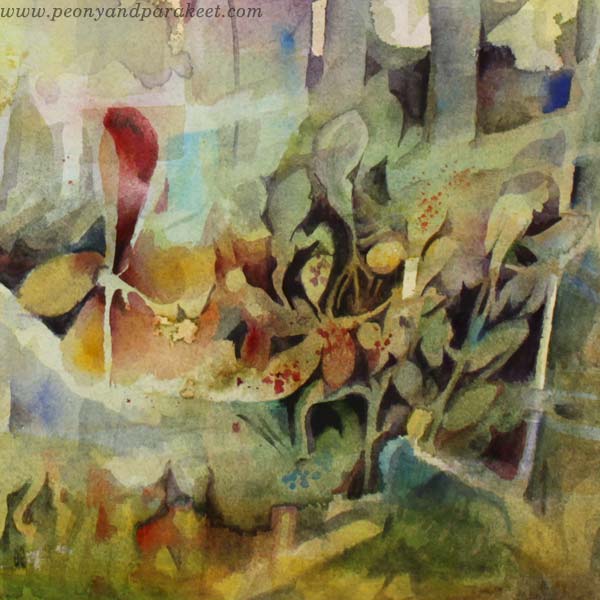
I have quite a few orchids to take care of nowadays. All of them don’t show in the picture below … These plants are as inspiring to me as the golden forests!
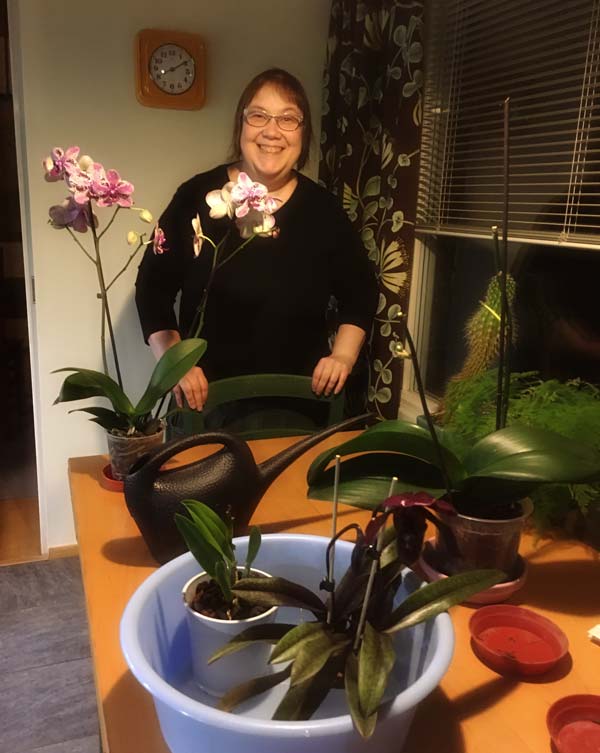
Fantasy Forest
Here’s the finished piece again, combining the ideas of seeing a forest as a luxurious place and expressing the love for orchids.

I hope this inspires you to paint a fantasy forest!
Hello Fall! – 10 Problems and Solutions for Watercolor Landscapes

It’s fall in Finland, and it’s a bit sad, even if it’s also beautiful. Our beagles Cosmo and Stella have their quilts, and when we go for a walk, we have to speed up because it’s getting colder every day.
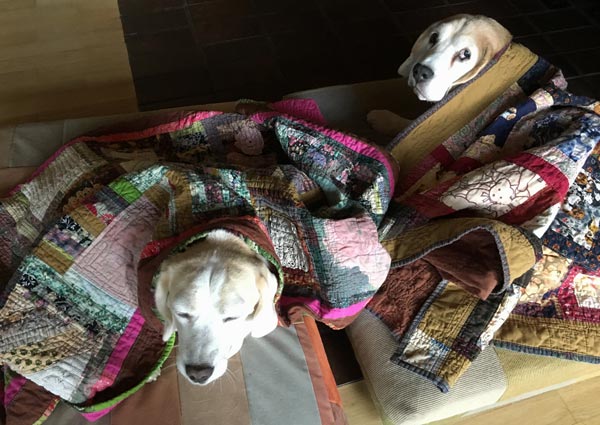
I have done a lot of drawing lately, and to relax a bit, I picked my watercolor set and a piece of Arches cold press watercolor paper. My watercolor set is a good friend, always ready for a new adventure. This time I started with a photo that was taken when walking the dogs, but I also painted freely. I hope you enjoy the video below!
10 Problem and Solutions for Watercolor Landscapes – Watch the Video!
Paint with me! Take a photo of the nature scene of your surroundings, and create a watercolor painting with this video tutorial. This time I built the video so that I picked 10 common problems in watercolor painting and explain how I solve them in practice.
Express Yourself by Painting Watercolor Landscapes – Buy Watercolor Journey!
Connect the dots between techniques and expression! Watercolor Journey has expressive watercolor techniques for beginners who want to loosen up and for more experienced artists who want to boost their imagination.
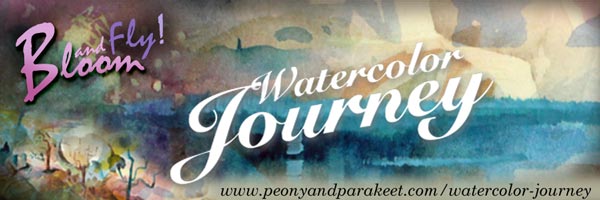
To celebrate the season and beautiful autumn colors of Finland, Watercolor Journey is for sale this weekend. Get 20 % off! The sale ends on Oct 6, 2019, midnight PDT.
Watercolor Interiors – Four Tips
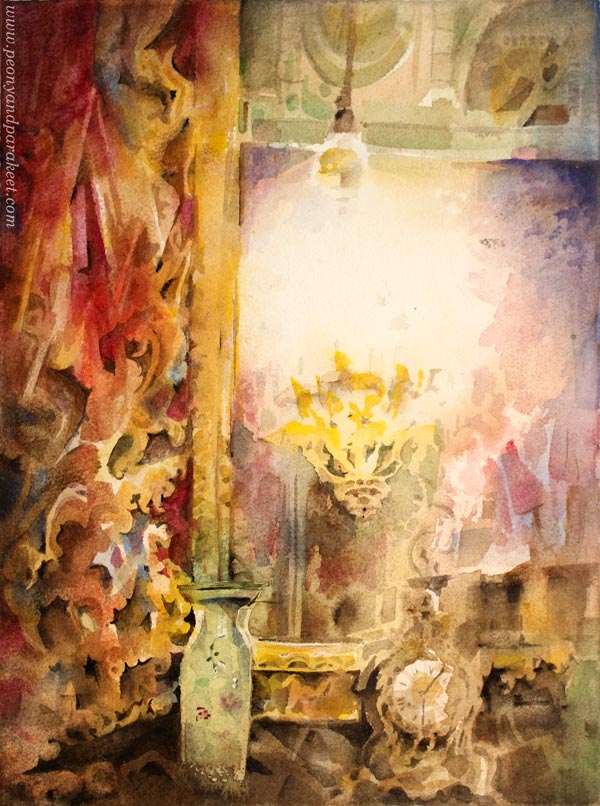
Here’s a watercolor painting that I made while being a student of Finnish watercolor artist Mika Törönen. I took the class to understand more about watercolors. Watercolor is a weird medium, and its weirdness fascinates me! Watercolors seem simple and easy at first. But the more you paint, and the more atmospheric you want your paintings, especially watercolor interiors, to be, the more challenging they become.
I have recently realized that more than outdoor sceneries, I love painting interiors. Here are some of my tips for painting watercolor interiors!
1) Start with Geometry and Positive Attitude
Last spring, I committed to learning more watercolor techniques. I built a class called Watercolor Journey.
In the past, when I was teaching IT professionals my colleagues often said: “You learn best when you are teaching.” First, it felt like cheating because I thought that teachers have to know everything already before starting a class. But when you have to break things into small manageable and teachable parts, deeper insights come up. This way I have found simple methods and easy guidelines for making rich and creative paintings.
This painting is made for the exercise of Watercolor Journey. It’s about painting geometric shapes and thus simplifying the interior. You can make the photo more blurry by squeezing your eyes, and focus on the flat shapes that you see from it, for example.
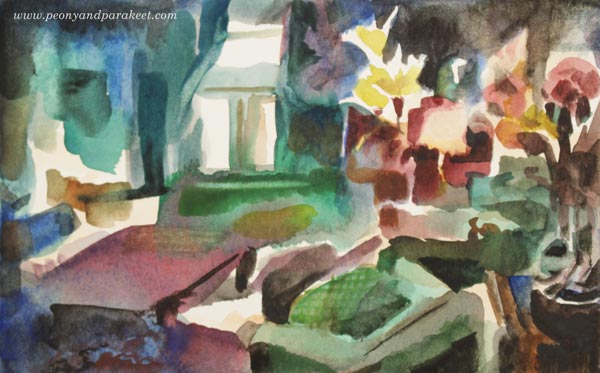
But methods, tips, and guidelines are not the only useful things that I have learned by building classes. By making sure that I teach with a smiling voice and appearance, I have learned to think positively about what I do and how to encourage myself. One of the most depressing things in classes is to hear negative self-talk, whether it comes from the teacher or the student. That’s why I think it’s important always to express positive emotions, the love for art, and all the enthusiasm that can be found from creating.
2) Choose a Reference You Love
Mika Törönen creates his beautiful paintings from the references. We also had to pick some for the class. I wanted to continue the inspiration that I got by visiting Italy a couple of years ago. I chose a snapshot taken from one of my favorite places – Palazzo Pitti, Florence. Many students used the same photos as references as the teacher did, but to me, it’s difficult to use references that I don’t have any connection.
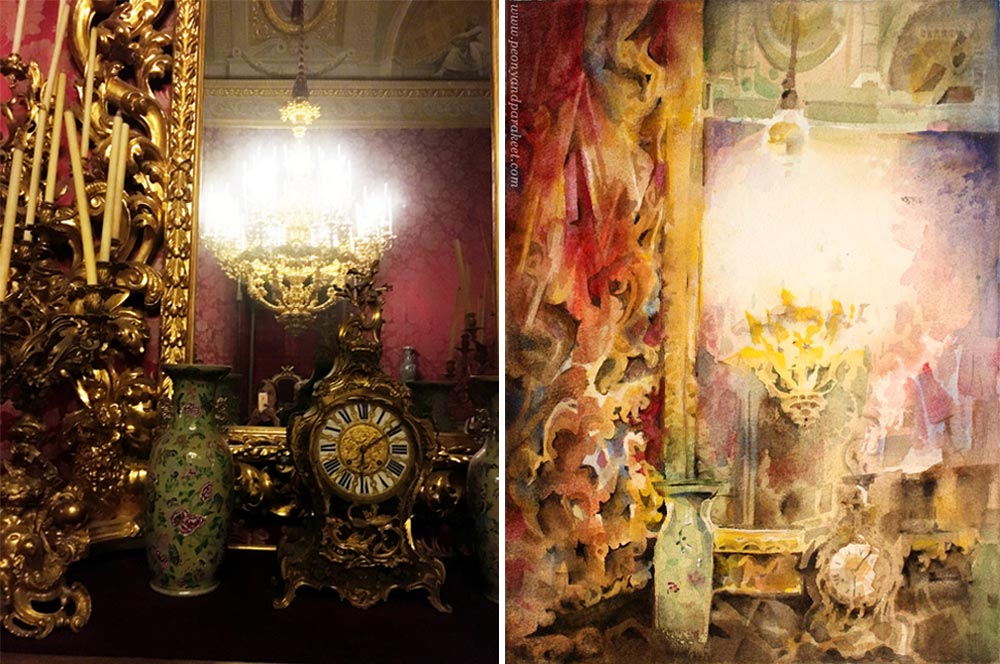
I didn’t aim for an exact copy but still, the photo was quite complicated and it took all the three sessions to complete to painting. I learned some tricks from Mika Törönen, like how to prevent the paper from curling while working (watch the video where I use the method for painting a watercolor bookmark), and the courage to use small shapes and lines of very thick paint when finishing.
The class was based on us students watching him paint. He wasn’t very good at translating his methods to words but as far as I saw it, a lot was to do with finding abstract elements from the photos and building a composition from that. He didn’t guide much, and the painting time was quite limited. The benefit for me was that I got new energy for working with watercolors. I painted a lot between the three weekly sessions.
3) Embrace Surreal to Express Emotions
One of the paintings that I have made recently, is this surreal interior. I used several references for this one and also worked quite loosely from them. Choosing one reference is not always the best starting point because it can control the work too much.
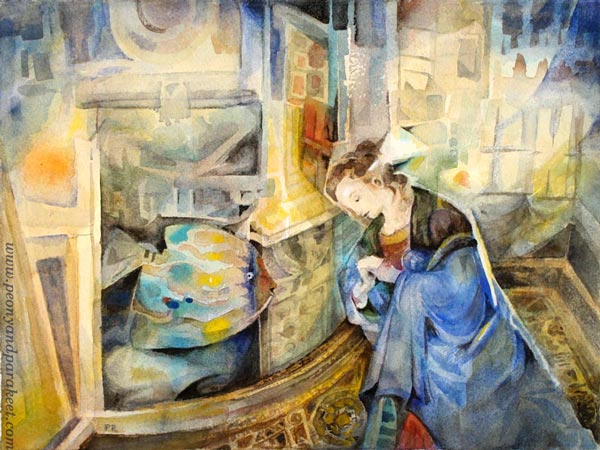
Here, my most important influencer was the feeling that I got after the first class session. The session was very quiet, and I felt the loneliness that felt both good and bad. Loneliness gives the chance to spend quality time with imagination. But of course, it is also a sad feeling.
When I have clarity about a specific emotion, I have both the positive and the negative aspect in mind. That tension inspires me to express it. In this painting, I used a fish to symbolize creativity that I connect with the time spent alone.
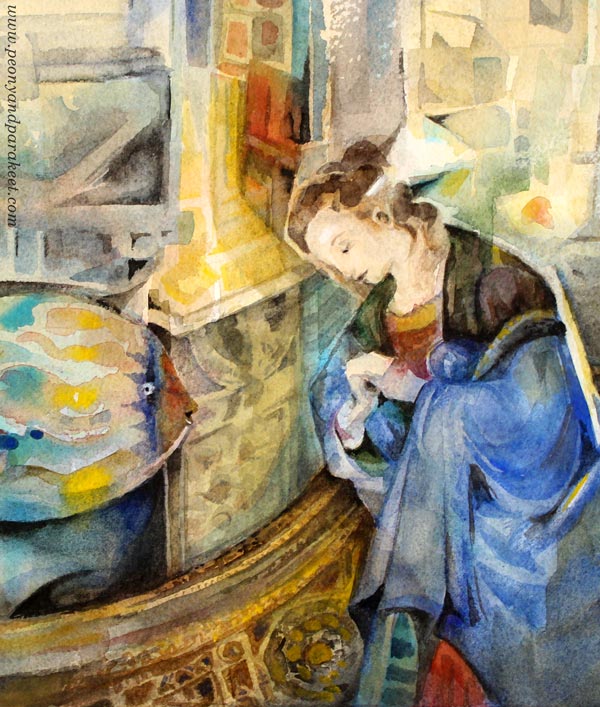
Often, the loneliness is in your head. You can feel alone even if you are surrounded by people. So I left a blank triangular ray of light that hits her head.
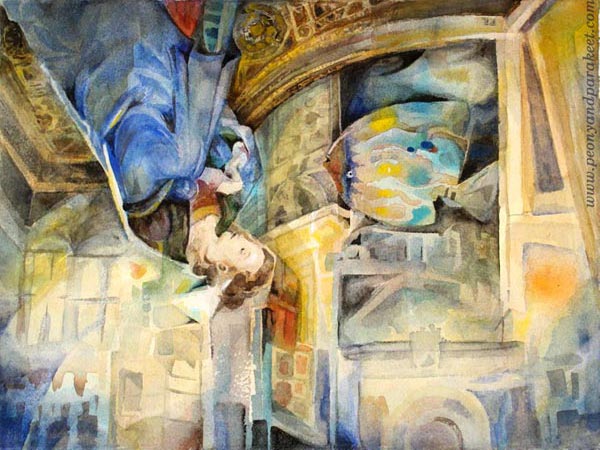
Working with creativity and without other people’s perspectives, can make things turn upside down. I used my photo of Palazzo Vecchio’s Hall of Five Hundred as a loose reference. If I turn the piece, you might recognize some of it.
4) Design the Lighting and Focus on the Light
Here’s my latest watercolor painting called “Eternity”. I think that it’s most loose of all the paintings of this blog post because here, I focused on the light.
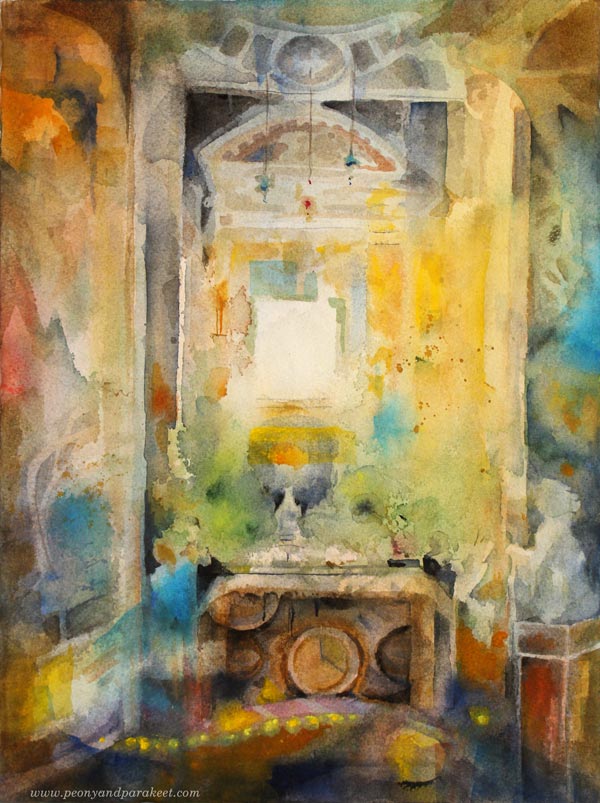
My reference photo was taken in an old church Chiesa del Gesu in Rome. It was only a starting point. After the first pale compositional layers, I abandoned it.
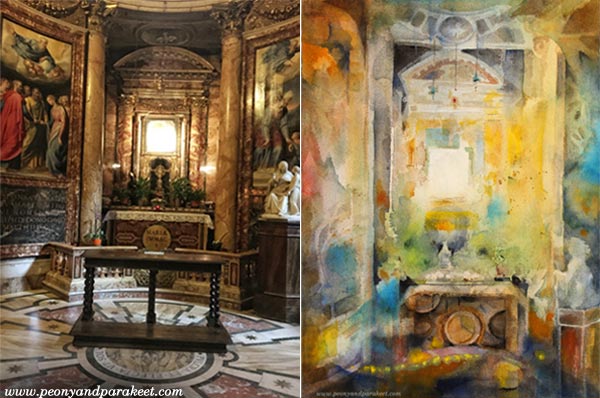
The elements and the lighting didn’t quite match my vision of
I used a lot of water when making this one! Sprayed, too!
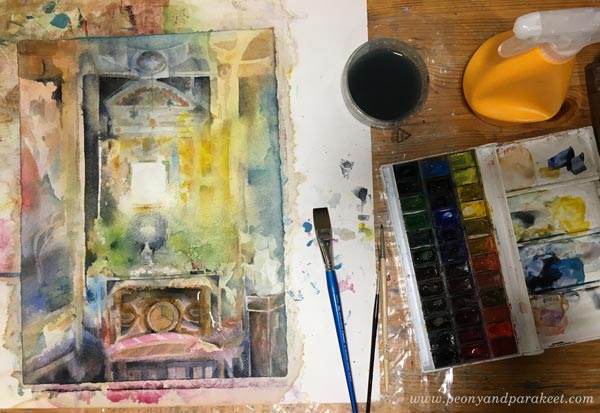
Watercolor Interiors – and Flowers!
I used Arches Rough 300 gsm watercolor paper for these three watercolor interiors. I hope that this blog post inspired you to pick your watercolor set and paint some watercolor interiors!
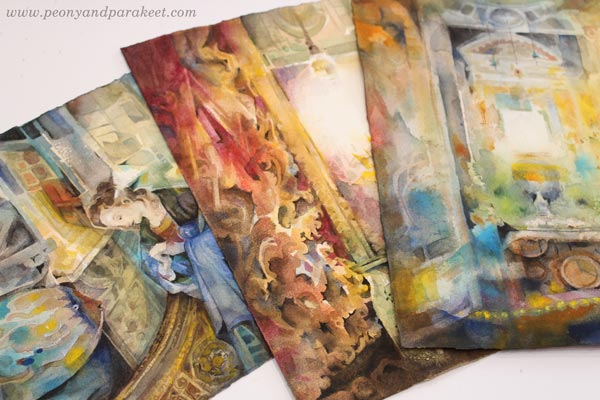
This spring I will rerun my class Floral Fantasies in Three Styles, where we paint watercolor florals, a very suitable theme to go with the interiors! There will also be an extra watercolor exercise, which will be available separately if you already have the class. Stay tuned!